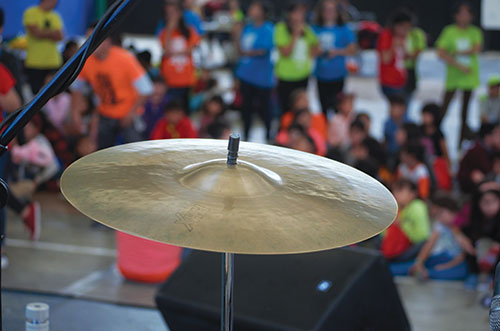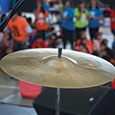The suspended cymbal is one of the simplest percussion instruments, but it requires detailed interpretation from student musicians. Classified as an unpitched idiophone, its body simply vibrates to produce a wash of sound. Percussionists must determine exactly how to make it vibrate to produce the appropriate sound for a given musical passage. Four important considerations for playing the suspended cymbal successfully are selecting the instrument, choosing appropriate mallets, monitoring playing spots and angle, and focusing on physical technique.

Selecting a Cymbal
Generally, concert suspended cymbals are manufactured to create a full wash of sound with no perceivable pitch. The best way to purchase new cymbals is to try several identical or similar ones with the same mallets, noting differences in their initial response, overall fullness, and gradual decay. Ideally, percussionists should have several cymbals of different sizes available to them for rehearsals so they can choose one that works best in a given situation. An 18" plate is probably the best first cymbal to purchase for your program, followed by 17", 19", and 16" cymbals, although not necessarily in that order. You might consider adding a new cymbal when the repertoire seems to require it. For example, a large, full, dark roll with a big crescendo might inspire you to invest in a 19" cymbal, while a piece with light, repeated, syncopated patterns might call for a 16" plate.
Assuming your students have several options available, selecting the best one for each situation requires attention to several physical factors, including diameter, thickness, and dimensions. Larger cymbals are usually better for dark, full sounds, sustained rolls, and gong-like effects, while smaller cymbals are useful for sharp attacks, metallic sound effects, and fast rhythmic passages. Remember, however, that the relationship between diameter and thickness can create vastly different colors from cymbal to cymbal. Diameter especially affects the potential volume and initial response, while thickness determines the color and pitch more substantially. Therefore, the combination of these factors may offer surprising resultant sounds, depending on how the cymbal is played and the context of the musical passage. A cymbal with a larger diameter does not necessarily mean that it will provide a bigger sound than a smaller one; it also depends on the thickness, and vice versa. Finally, the dimensions of the cymbal are the relative size of the bell and curvature of the body. These dimensions contribute substantially to the effectiveness of a given plate, especially for specific sound effects. In all cases, students should try several cymbals, if possible, instead of assuming that one is the best choice from the start. They may also need to use more than one cymbal on a single piece, even if the part is simply marked suspended cymbal throughout.
Choosing Mallets
While any number of implements can be used, some of which are prescribed in detail by composers, percussionists typically use yarn-wrapped mallets to play standard suspended cymbal parts. The wrapping should be consistent and full around the entire mallet head. Most commercially made mallets are wrapped quite well at the factory, but even minimal use can begin to wear the yarn at various spots. Uneven wrapping creates potential for uneven sound, especially on sustained rolls. To protect the yarn over time, make sure students store their mallets in the plastic bags in which they were shipped or in padded bags designed for mallets.
Percussionists can use specifically designated suspended cymbal mallets, but some vibraphone and marimba mallets also work quite well. Just as it is ideal to have several cymbals available from which to choose, it is important to have several pairs of mallets that can match them in different musical ways. Finding the right mallets for a piece requires experimentation, to compare the effects of mallet head size, amount of yarn wrap, and length and material of shafts, for example. One guideline to keep in mind is that the mallet heads should be heavy enough to set the cymbal fully into motion, even at a soft dynamic. For both single attacks and sustained rolls, the whole cymbal should be vibrating fully, unless the composer purposefully calls for a superficial, shimmering sound. Students can experiment with the contrast between the unsatisfactory sound of mallets that are too small for the plate and the full sound of mallets that match the cymbal appropriately.
Playing Spots and Angles
Composers may indicate any of three main parts of the suspended cymbal in typical passages: the bell (raised cone in the center), bow (main section of the cymbal), or edge. When playing the bell, students should experiment with various implements and angles. For example, a snare drum stick produces a much different sound when striking the bell on top with the tip than on the side with the shoulder. These two parts of a stick produce a similar contrast when playing on the bow – a pointed ping versus an aggressive metallic attack, respectively. A stick or other hard implement can also be used at the edge of the cymbal, played with the shoulder at about a 45-degree angle to create a fuller crash.
Perhaps the most common playing spots are on the very edge, given that both single sounds and sustained rolls are produced with yarn mallets there. The mallets should generally strike flat on the surface, so that the largest possible area of the mallet head makes contact. A common mistake among developing percussionists is playing in too far from the edge. They may think they are playing at the edge, but just an inch or so inward reduces the quality and fullness of sound dramatically. Have students experiment with how close to the edge they can play before their mallets actually miss the cymbal. They may be surprised and can then move the mallets in slightly to get the best sound. When rolling, the lateral angle between the two mallets can vary depending on dynamics, but avoid playing the two mallets exactly opposite each other (e.g., three o’ clock and nine o’ clock); this can cause the cymbal to rock back and forth uncomfortably.
Physical Technique
Most suspended cymbal parts are relatively simple rhythmically, but achieving high-quality sounds is dependent on technical nuance. The slightest variation in physical technique can make or break the resultant sound. Generally, single notes and spaced groups of notes are played at the very edge with a legato stroke (like playing a large bell or gong, for example). This can be done with one mallet, and usually is, although playing with two mallets near each other at the edge can make single notes sound more full. Note that the cymbal does not speak as quickly as, for example, a snare drum or xylophone, so percussionists will often play a legato note slightly ahead of the beat to match an ensemble entrance. In contrast, faster rhythmic passages, or any note that requires a sharp attack, should be approached with a more staccato stroke, similar to playing the snare drum. Players will need to adjust their stick velocity and rebound (providing more upstroke) to make sharp attacks speak effectively. Finally, shorter notes, or any notes for that matter, may require muffling. The non-playing hand simply closes around the edge of the plate to cut off the sound. Incorporating muffling into rhythmic passages sometimes presents surprisingly difficult coordination challenges, which may require slow, choreographed practice.
One additional technical tip is that students tend to play suspended cymbal sustained rolls too quickly. Percussionists can achieve a smooth, sustained roll on the suspended cymbal with a much slower roll speed than they would use on a snare drum or timpani, so students will need to calibrate their hands accordingly. Have them experiment with slow and fast rolls, noticing the differences and discovering what works well for a given dynamic. Ultimately, the goal is simply to keep the plate in full, consistent motion for the duration of the marked note. Sensing how fast the hands need to move to maintain the vibrations requires experimentation. In fact, for all recommendations provided here, students will be served best by time and opportunities to experiment with how a range of approaches affects their sound. If they can imagine the ideal sound for a given passage – perhaps with the director’s guidance – they can then manipulate the options described to produce it. Encourage percussionists to be persistent in their quest for the best cymbal sounds they can possibly create.






